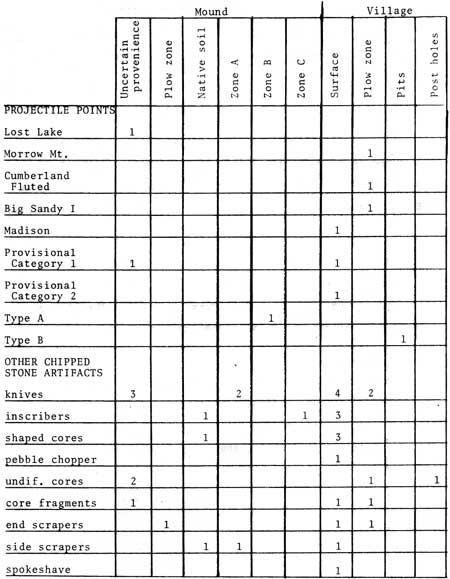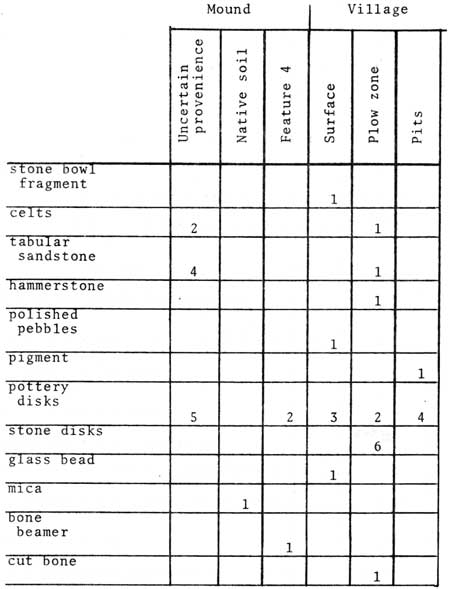|
NATCHEZ TRACE PARKWAY
Excavations at the Pharr Mounds and the Bear Creek Site |

|
ARTIFACTS
The provenience of the projectile points and other chipped stone artifacts in the Bear Creak mound and village is given in table 3.
TABLE 3.--Provenience of projectile points and other chipped
stone artifacts, Bear Creek Site

(click on image for a PDF version)
Projectile Points
The array of projectile points recovered constitute an interesting side-light on the history of the Bear Creek Site. Several of the types were manufactured during Paleo-Indian or Early Archaic times, many thousands of years before the earliest pottery makers arrived on the scene.
With the exception of types "A" and "B," which are purely descriptive categories, the points were identified by James W. Cambron. The dates were taken from the Alabama Handbook (Cambron and Hulse, 1964).
Lost Lake (fig. 12a)
This type is represented by the base of a large point with straight, serrated edges. One face of each edge is beveled, producing rhomboid cross section. Deep, U-shaped corner notches form simple, sharply pointed barbs and expanding stem. Estimated age: Early Archaic, ca. 3000 B.C.
Morrow Mountain (fig. 12b)
One complete specimen. Medium-size, stemmed point, planoconvex in cross section. Recurved blade edges; shoulders horizontal and slightly expanded; contracting stem with rounded base. Estimated age: Early Archaic, 4500 B.C. Length: 5.8 cm. Width: 2.5 cm. Thickness: 0.8 cm.
Cumberland Fluted (fig. 12e)
This type is represented by one proximal fragment with auriculate base intact. Channel flake scar does not extend to base, which is beveled. Basal and lateral edges ground. Estimated age: Paleo-Indian, 8000 B.C. or older. Width at base: 2.1 cm. Thickness: 0.6 cm.
Big Sandy I (fig. 12f)
One specimen. Medium-size point, lacking part of base. Flattened in cross section. Shallow side notches form rounded, expanded auricles. Base concave. Edges of notches and base ground. Estimated age: Early Archaic, 8000 B.C. or older. Length: 2.4 cm. Estimated width: 2.7 cm. Thickness: 0.6 cm.
Madison (fig. 12j-l)
Three specimens. Small points. Flattened in cross section. Blade edges straight to slightly concave, serrated in one example; base straight. Estimated age: Mississippian period, probably contemporaneous with the mound and village. Length: 3.4 cm. (complete specimen). Width: 0.9-1.8 cm. Thickness: 0.4-0.6 cm.
Provisional Category I (fig. 12g and h)
Reference: Cambron and Hulse, 1964.
Two complete specimens. Medium-size, stemmed points. Biconvex in cross section. Blade edges straight to slightly convex; shoulders narrow, tapering; straight stem with slightly convex edges and straight or convex base. Stem edges and base ground in one example. Length: 4.2 and 4.4 cm. Width: 2.2 and 2.6 cm. Thickness: 0.9 and 0.8 cm.
Provisional Category II (fig. 12i)
Reference: Cambron and Hulse, 1964.
One complete specimen. Cambron (personal communication) believes that this may be a Jacks Reef Corner-Notched point. Small, stemmed point. Flattened in cross section. Broad blade with convex edges; shoulders narrow; wide, expanding stem with straight edges and base. Length: 2.1 cm. Width: 1.5 cm. Thickness: 0.5 cm.
Type "A" (fig. 12c)
One complete specimen. This point does not resemble any of the described types and has been placed in a descriptive category. Medium-size, pentagonal point. Biconvex in cross section. Edges of upper portion of blade straight, converging near tip; edges of lower blade straight, ground near base; base straight. Length: 4.8 cm. Width: 2.6 cm. Thickness: 0.9 cm.
Type "B" (fig. 12d)
One specimen, lacking the tip. This is also a descriptive category. Medium-size, side-notched point. Planoconvex in cross section. Blade edges straight; U-shaped notches form blunt auricles; base slightly concave. Length (estimated): 4.1 cm. Width: 2.2 cm. Thickness: 0.8 cm.
Blank
This specimen, showing primary percussion chipping only, is apparently an unfinished leaf-shaped point with a concave base.
Other Chipped Stone Artifacts
Knives (fig. 14a-e)
These are bifacially chipped artifacts which vary from triangular to laurel leaf in shape. They are biconvex or, rarely, planoconvex in cross section. In the latter case, the ventral side is a single flake scar. They are generally roughly chipped with sinuous edges, but in a few instances the edges were retouched by pressure flaking. Only two specimens are complete, and the following measurements are estimated. Length: 0.5-8.0 cm. Width: 2.5-4.5 cm.
Inscribers (fig. 14l-o)
These tools have blunt, rounded ends which are use-scarred and, in one case, slightly ground. All are relatively thick and crudely chipped. Two specimens are elongated blades; one has a series of shallow notches pressure flaked in the sides. The remaining two examples are larger flakes with narrow, beak-like projections. This class of artifacts is related to the burins and perforators described from other sites. Only the tips of the examples from the Bear Creek Site show evidence of usage suggesting that they were used for engraving or incising. The following measurements are for the elongated examples. Length: 3.7-5.2 cm. Width: 1.4-1.6 cm. Thickness: 0.5-0.6 cm.
Shaped Cores (fig. 15a-c)
These are thick, crude cores which are ovate or laurel leaf in shape. They show percussion flaking only. Portions of the edges of all examples reveal some battering. Such artifacts are frequently identified as "choppers," but the small size of these specimens would make them chopping tools of limited efficiency. Length: 6.9-8.4 cm. Width: 3.9-5.6 cm. Thickness: 2.1-2.8 cm.
Pebble Chopper
This artifact is a thick, crude implement, one side of which is the cortex of the pebble. It is wedge-shaped and was manufactured solely by primary percussion chipping. The battered edge suggests its function but, as with the tools described in the preceding group, its small size makes it a rather unsatisfactory chopping implement. Length: 6.7 cm. Width: 5.1 cm. Thickness: 3.0 cm.
Unidfferentiated Cores (fig. 15e-g)
This group includes four crude, amorphous cores which were shaped by primary chipping. They appear to be unused and their function is unknown. Length: 3.5-5.3 cm. Width: 2.4-4.4 cm. Thickness: 1.7-3.7 cm.
Core Fragments
These are apparently fragments of larger tools. On each specimen, one side is a single flake scar, and the opposed face shows the primary chipping of the parent core. None show evidence of use.
End Scrapers (fig. 14f-h)
These are roughly triangular flakes with steep, thick scraping edges produced by unifacial pressure flaking. They were roughly shaped by percussion chipping. Length: 3.8-5.9 cm. Width: 3.1-4.0 cm. Thickness: 1.1-1.5 cm.
Side Scrapers (fig. 14i-k)
These tools have broad, thin scraping edges. They were roughly shaped by primary chipping and the edges were retouched by unifacial pressure flaking. Length: 4.4-5.9 cm. Width: 3.0-3.5 cm. Thickness: 0.9-1.5 cm.
Spokeshave (fig. 15d)
This is a large flake, one side of which is a single flake scar. A deep notch has been unifacially chipped in one side to form a concave scraping edge. Length: 9.7 cm. Width: 3.8 cm. Thickness: 2.0 cm.
Ground Stone Artifacts
The provenience of ground stone artifacts, other artifacts, and miscellaneous materials is given in table 4.
TABLE 4.--Provenience of ground stone artifacts, other
artifacts, and miscellaneous materials, Bear Creek Site

(click on image for a PDF version)
Stone Bowl Fragment
This appears to be the fragment of a steatite bowl, 1.3 cm. thick.
Celts (fig. 13b)
One complete specimen of granite and two fragments of greenstone were recovered. The granite celt is roughly triangular, with convex sides and a rounded poll; it is flattened in cross section. The bit is well battered. In contrast, the bits of the greenstone specimens show no signs of use. Length: 9.7 cm. Width at bit: 4.4 cm. Thickness: 2.5 cm.
Tabular sandstone
In the immediate vicinity of the site, Bear Creek flows over formations of tabular sandstone. Five fragments of such material apparently used as grinding anvils were found. The edge of one specimen had been abraded to form a smooth margin, but the others were unaltered.
Hammers tone
This is an unshaped stream cobble, of a convenient size to be held in the hand. One end and a side are battered.
Polished Pebbles
Several stream-polished pebbles were picked up from the surface. One specimen was a perfect disk and had apparently been altered by use.
Pigment
A lump of light, porous, fossiliferous mineral, with one side ground flat, was collected. The mineral is deep maroon in color and produces a fine, brick-red powder which may have been used as a pigment.
Other Artifacts and Miscellaneous Materials
Pottery disks (fig. 13c-e)
Varying from 2.4 to 4.8 cm. in diameter, these disks were cut from coarse shell tempered pottery.
Stone disks (fig. 13f-h)
These are the stone counterparts of the pottery disks described above. One is greenstone, four are of sandstone, and one is of a reddish-brown sedimentary mineral. They range in diameter from 3.0 to 4.9 cm. and in thickness from 0.8 to 1.7 cm.
Glass bead
This trade bead was a surface find. It is cylindrical, with a faceted surface, and is compound. The inner core is a translucent, milky white; the outer is clear. It measures 0.5 cm. long and 0.6 cm. in diameter. The orifice is 0.2 cm. in diameter.
Mica
A small sheet of unworked mica was found in the mound fill.
Bone Artifacts
Two specimens of worked bone were found. One was apparently used as a beamer or hide scraping tool (fig. 13a). It was made from the long bone of a large mammal which was cut or abraded to form a rounded scraping edge. The other specimen is a bird bone with two small holes cut in one side. Its function is unknown.
| <<< Previous | <<< Contents>>> | Next >>> |
pharr_mounds-bear_creek/sec5-2.htm
Last Updated: 15-May-2008